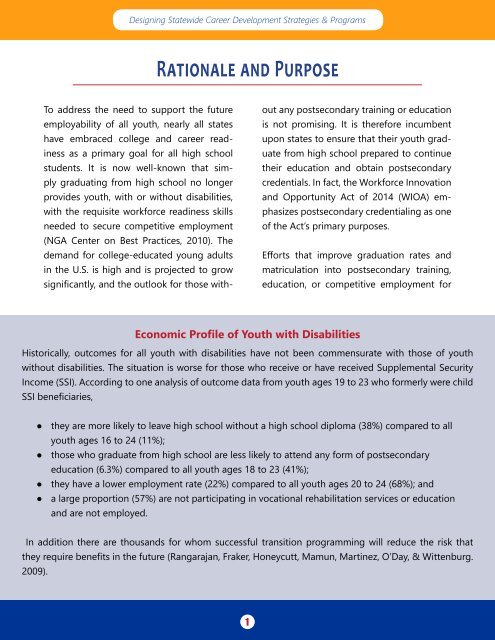Designing Statewide Strategies & Programs
DesigningStatewideCareerDevelopmentStrategiesProgramsPub_0
DesigningStatewideCareerDevelopmentStrategiesProgramsPub_0
Create successful ePaper yourself
Turn your PDF publications into a flip-book with our unique Google optimized e-Paper software.
<strong>Designing</strong> <strong>Statewide</strong> Career Development <strong>Strategies</strong> & <strong>Programs</strong><br />
Rationale and Purpose<br />
To address the need to support the future<br />
employability of all youth, nearly all states<br />
have embraced college and career readiness<br />
as a primary goal for all high school<br />
students. It is now well-known that simply<br />
graduating from high school no longer<br />
provides youth, with or without disabilities,<br />
with the requisite workforce readiness skills<br />
needed to secure competitive employment<br />
(NGA Center on Best Practices, 2010). The<br />
demand for college-educated young adults<br />
in the U.S. is high and is projected to grow<br />
significantly, and the outlook for those without<br />
any postsecondary training or education<br />
is not promising. It is therefore incumbent<br />
upon states to ensure that their youth graduate<br />
from high school prepared to continue<br />
their education and obtain postsecondary<br />
credentials. In fact, the Workforce Innovation<br />
and Opportunity Act of 2014 (WIOA) emphasizes<br />
postsecondary credentialing as one<br />
of the Act’s primary purposes.<br />
Efforts that improve graduation rates and<br />
matriculation into postsecondary training,<br />
education, or competitive employment for<br />
Economic Profile of Youth with Disabilities<br />
Historically, outcomes for all youth with disabilities have not been commensurate with those of youth<br />
without disabilities. The situation is worse for those who receive or have received Supplemental Security<br />
Income (SSI). According to one analysis of outcome data from youth ages 19 to 23 who formerly were child<br />
SSI beneficiaries,<br />
●●<br />
●●<br />
●●<br />
●●<br />
they are more likely to leave high school without a high school diploma (38%) compared to all<br />
youth ages 16 to 24 (11%);<br />
those who graduate from high school are less likely to attend any form of postsecondary<br />
education (6.3%) compared to all youth ages 18 to 23 (41%);<br />
they have a lower employment rate (22%) compared to all youth ages 20 to 24 (68%); and<br />
a large proportion (57%) are not participating in vocational rehabilitation services or education<br />
and are not employed.<br />
In addition there are thousands for whom successful transition programming will reduce the risk that<br />
they require benefits in the future (Rangarajan, Fraker, Honeycutt, Mamun, Martinez, O’Day, & Wittenburg.<br />
2009).<br />
1


